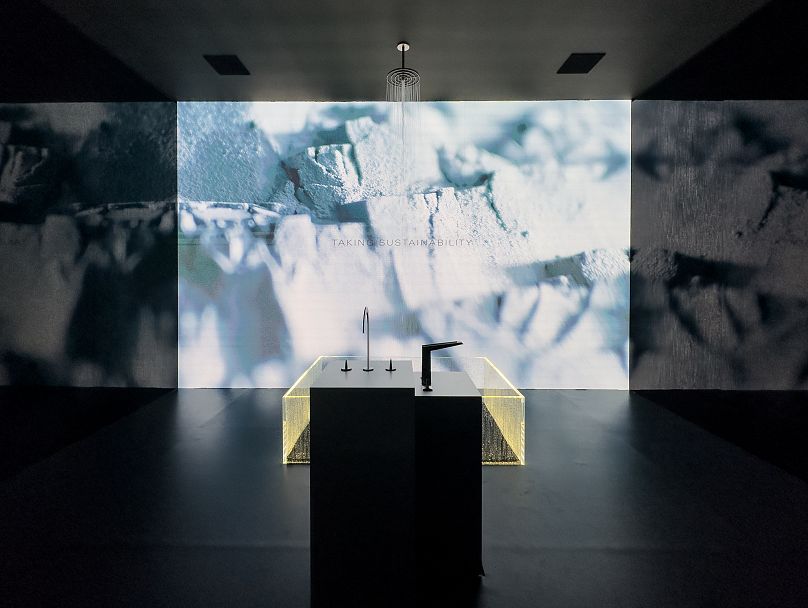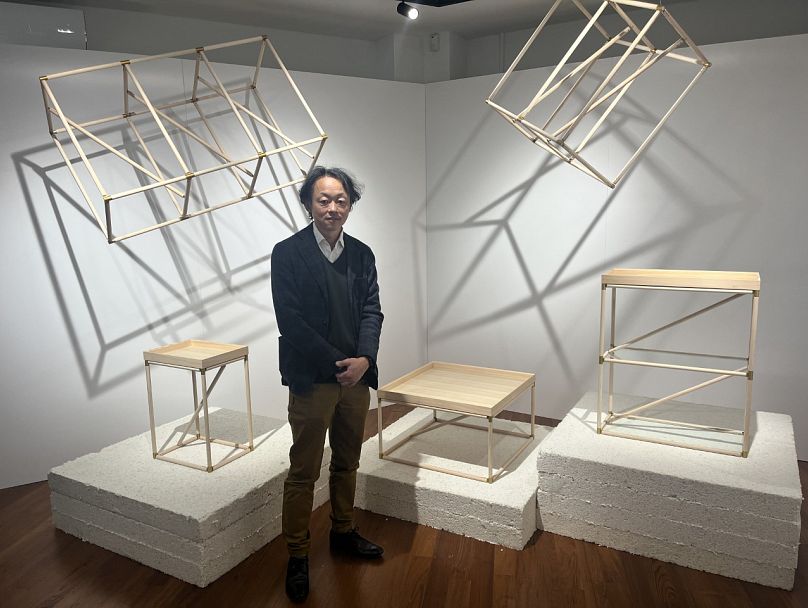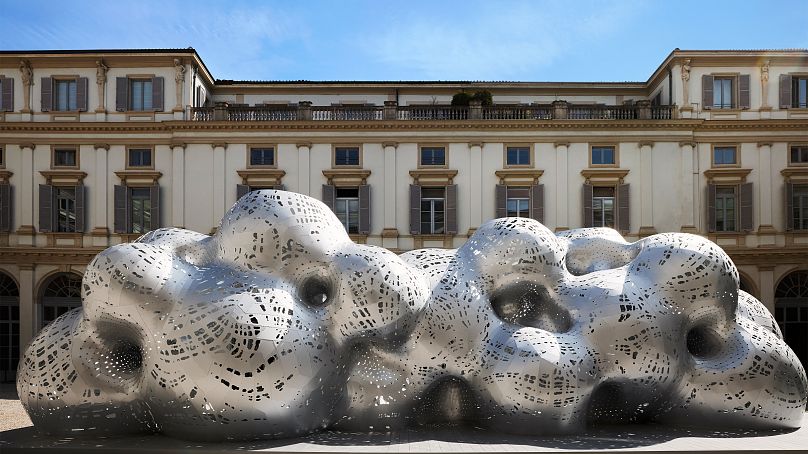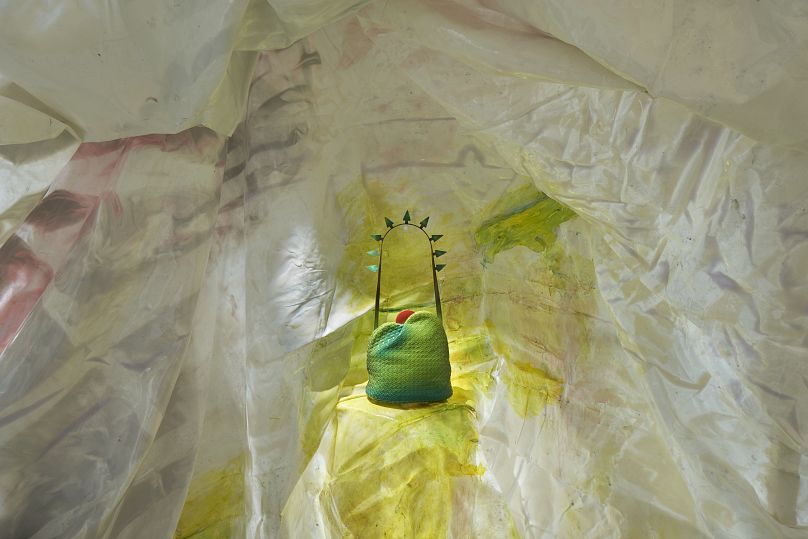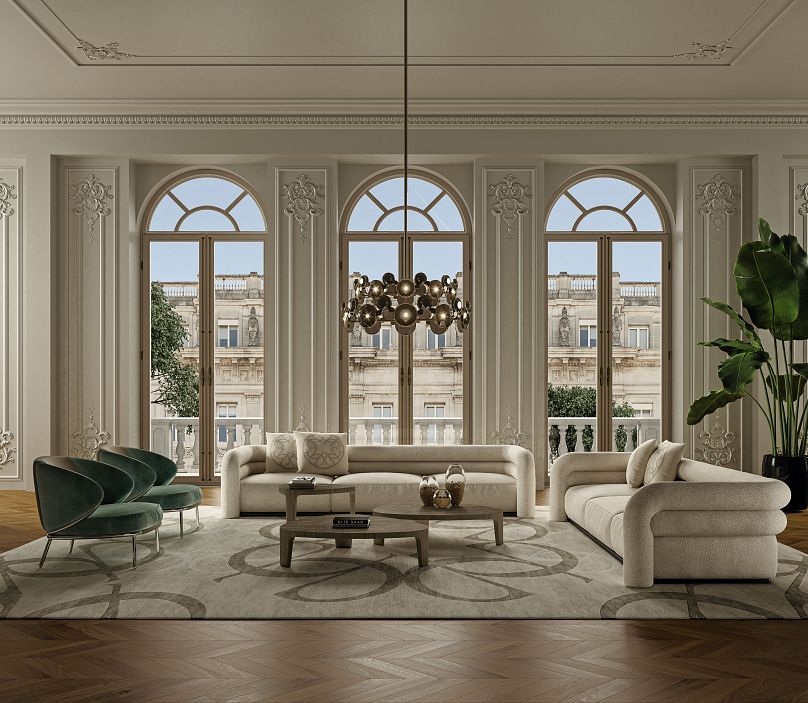Coming hot off the heels of Milan Design Week, it's International Design Day. Euronews Culture takes a look at the hottest trends in interiors to come from the Salone.
International Design Day (IDD) is 60! Today marks six decades since the International Council of Design was founded on 27 April 1963.
This year’s theme is ‘Peace. Love. Design!’ and the Council is harking back to its 60s roots. This IDD has a particular focus on the peace sign, designed by British graphic artist Gerald Holtom initially as a logo for the Campaign for Nuclear Disarmament. By the mid-sixties, the CND symbol was used more widely in all protests against war.
With this in mind, International Design Day aims to encourage people to think of design’s role in issues facing the world, like war, climate change, economic challenges and political polarisation.
While today raises questions of how much design can help to play a positive role in changing the world for the better, Euronews Culture is diving into trends from our visit to Milan Design Week, which ran from 18 - 23 April.
Also known as the Salone Internazionale del Mobile di Milano, the world-famous fair is even older than IDD, having taken place for the first time in 1961. This year’s event marked the first full week since the COVID-19 pandemic and was back to its former glory, attracting hundreds of thousands of visitors.
It’s the largest fair of its kind in the world, showcasing the latest and best in furniture, homewares and design from across the globe and more than 2,500 companies put their wares on display between the vast Fiera Milano exhibition space as well as in the city centre.
Unsurprisingly, artificial intelligencewas a big talking point in Milan, with numerous exhibitors using AI in their creations, often alongside traditional design and manufacturing.
German company Grohe’s takeover of Milan's Pinacoteca di Brera museum was one of the Salone’s hottest tickets, where they showcased pieces from their premium sub-brand, Grohe Spa, including new 3D printed metal taps and prototype showerhead. Speaking to Euronews Culture_,_ designers for the brand explained the process takes around 20 hours for each piece, but significantly lessens waste, ensuring that AI technology is environmentally friendly as well as efficient.
French designer Audrey Large returned to Milan for her biggest Design Week show to date, putting on display furniture hand-drawn on a tablet and realised using a 3D printer. Large speaks of getting inspiration from digital forms and using her design skills to explore the relationship between the physical and virtual world.
Similarly to Audrey Large, American designer Ryan Decker is influenced by a computer-generated, metaverse-inspired aesthetic and, at the Salone, his show aimed to blur the boundary between digital and physical design. At the off-schedule Alcova exhibition, held in a former abattoir, Decker presented a series of alien-looking lights, which combined flat aluminium sheets, printed with digital 3D renders and AI-generated textures alongside sculptural handmade components.
Taking AI several steps further was Australian design house Studio Snoop, who introduced ‘Tilly Talbot’, apparently the ‘world's first AI designer’.
While she appeared as a young woman on the brand’s social media, Tilly is in fact a chatbot in the vein of ChatGPT who used Design Week to allow visitors to give feedback and make changes to products from the existing range.
Studio Snoop’s founder, Amanda Talbot, explained that she believes it’s important for designers to work with AI rather than rejecting it, saying: “Bringing Tilly to life has brought a new energy and new possibilities into what we design. Rather than shying away from this remarkable technology, I have seen it as a duty for my studio to begin training her with emotional intelligence to give her clear design principles and values that will greatly benefit humankind and nature”.
The Studio uses Bauhau-AI, created in-house, and Talbot says it is "a movement we have created to embody this new-era of designs specialising in combining nature, craft, art, design, and artificial intelligence technology”.
Sustainability was also a huge talking point at the Salone. This was to be expected as climate change discussions rage on across the globe. Designers across the event put their wares on show in an attempt to encourage consumers to think in a more environmentally friendly way when it comes to choosing pieces for their own lives and homes.
Korean furniture designer Subin Seol’s collaboration with Retrouvius, who put salvage and vintage pieces back into circulation and uses the slogan ‘re-use is our philosophy’, was a huge hit in Milan. She used handrails from the Fawley Power Station in the south of England and designed and created a dining chair and a coffee table. Seol explained that by embracing the handrails' distinctive and irregular shape, she intended to retain the now demolished building's brutalist aesthetic, while celebrating its heritage and not wasting any salvageable materials. remembering and celebrating the old landmark's heritage.
The use of waste materials was prominent across Milan, with designers looking to reduce the environmental impact of their pieces.
Euronews Culture spoke to Takeda Katsuya, who runs a design studio in Milan’s Brera District which launched its BRACE collection in collaboration with the Tatehiko factory in the Tochigi Prefecture north of Tokyo. Each piece in the range is made up of light wood and their slimness means they can be shipped worldwide in small packages, lessening emissions and working towards a climate friendly industry.
The wood itself is pretty special too and plays into Katsuya’s ethos that nothing should be wasted. Made from Hinoki wood, which is only able to grow in very specific conditions, the factory prides itself on "using finite resources with utmost care" and, as a result, the pieces in the BRACE collection are all made using small offcuts from larger furniture pieces.
Other designers encouraged visitors to the Salone to think more deeply about their consumption of products, with Dutch designer Kick Veldman creating mirrors made from waste aluminium and inviting people to look at their reflections in ‘junk’ created by society.
Similarly, the American PROWL Studio collaborated with M4 Factory, which specialises in regenerative plastic goods, to create the PEEL chair, while tackling the issue of so-called fast furniture. It’s a reimagining of the hugely familiar plastic stacking chair, but, instead, made from sustainable hemp bast fibre, a byproduct of hemp and cannabis processing that typically goes to waste. The collaboration put the chair on show in various stages of decomposition, challenging visitors to think about the end of a product’s life cycle at the point of purchase.
The conversation at Milan Design Week was also surrounding the sustainability not just of the pieces produced, but also the event itself.
While any show on its scale will no doubt have a significant environmental impact, the Salone organises have continually stepped up their commitment to improving sustainability in recent years. They’ve signed up to the UN Global Compact corporate’s sustainability pledge for 2023 and also updated voluntary guidelines for exhibitors, while working towards collaborating with more organisations committed to caring for the planet.
With a focus on sustainability, it will come as no surprise that many designers at the Salone took inspiration from the natural world in their offerings.
Forma Rosa Studio presented their first solo show ‘Natura Oscura’ at the Alcova venue, explaining that they aimed to display “elements of man-made infrastructure… juxtaposed with nature's greenery growth, creating and reimagining our relationship with the world around us”.
Their collection was inspired by the post-pandemic world, where humans have become more isolated from nature, and took inspiration from natural phenomena, including from a fractal growth called ‘Botryoidal’ that inspired their Botryoidal Lamps.
Forma Rosa also used AI alongside traditional pottery techniques for their ceramic offerings, using an algorithm to generate shapes of stools and lights before putting finishing touches to each piece by hand.
French fashion powerhouse Louis Vuitton took over the stunning Palazzo Serbelloni to showcase its new projects, including a collaboration with New York based MARC FORNES / THEVERYMANY.
Called ‘Nomad’, the team produced a vast and intricate pavilion designed and served as an example of the architect’s signature coral-like designs. The ultra-thin structure is made up of 1,600 uniquely shaped and patterned aluminium sheets, some as thin as 1 millimetre, and Louis Vuitton explained its ties to the natural world, saying it resembles “a living being that has organically bubbled up from the Palazzo's courtyard".
Atelier LUMA, part of France’s cultural centre LUMA Arles, brought its work exploring bioregional design practices in the South of France and beyond to Design Week.
Every piece on show was inspired by nature across the south of France, the Mediterranean basin and beyond and used a combination of human resources and sustainable and easily available natural materials.
At the Salone, LUMA displayed five large installations, all of which offered sensory experiences rooted in specific natural settings. The team used rice straw, salt, local fabrics and wool, giving visitors a chance to see for themselves the bioregion surrounding Arles, through sound, light, colours, patterns and textures.
They also transformed algae and agricultural by-products into bioplastic seats and used traditionally Middle Eastern materials like palm leaves to put a new spin on regular furniture designs. As well as being inspired by nature and using it for their creations, LUMA also salvaged construction materials and upholstery fabrics, to name just a couple of materials, to make their collection which took Alcova by storm.
Ignoring a potential global recession, one huge trend - which will likely never go away on Italian soil - was maximalism.
Dolce and Gabbana led the pack, following its splashy Casa homewares line two years ago. The fashion house collaborated with 10 up-and-coming designers for the Salone, from Murano glass artists to wicker makers from Sicily. While it was a huge celebration of Italian design and craftsmanship, none of it - unsurprisingly - was subtle. The standout? Probably the unmissable installation by Antonio Aricò which took over the top floor of Dolce and Gabbana Casa’s Via Broggi boutique. It was inspired by a limonaia - or lemon greenhouse - and everything was in a stinging yellow tone and inspired by classical antiquity. This being Dolce and Gabbana, the collaboration went one step further and even included embellished brooms to sweep away leaves that dropped from surrounding trees - in chartreuse, of course.
Italian design house Fornasetti has packed a maximalist punch since its foundation in the 1940s and its 2023 Salone launch didn’t disappoint.
The brand unveiled three new collections, all dipping into themes from their remarkable, stand out archive. ‘Giro di Conchiglie’ features three-dimensional sea-themed images including, of course, shells and a blue-coloured background including a hand painted water-streaking effect. ‘Giardino Settecentesco’ uses vibrant colour and a new take on toile du Jouy, inspired by the meeting place of natural landscapes and neoclassical style buildings and the ‘Musciarabia con Rose’ collection plays into the brand’s famous geometry and black lines, making it pop further with the addition of hand painted pink flowers.
Visitors to the installation at Fornasetti’s flagship store were also able to see pieces from the archive, including its vast, iconic collection of ceramics featuring the face of opera singer Lina Cavalieri. They really are the definition of maximalism.
This being Milan, there was no escaping the trend - and La DoubleJ made sure of that.
The Milan-based clothing and homewares brand used the Salone to launch their expansion into wallpaper and did it in spectacular style. Founder JJ Martin gave a maximalist makeover to the bathrooms of eight of her favourite spots across the city including eateries like Pasticcerias Cucci and Cova, the Apophis Club and, of course, the La DoubleJ flagship store on the exclusive Via Sant Andrea. All of the prints packed an enormous punch and certainly gave visitors to these WCs something to look at - and talk about.
Fashion collided with interior design at the Salone and, while fashion houses from across the globe have long been present as Design Week, since furniture sales were sent skyrocketing by the pandemic, many more clothing designers have wisely chosen to take advantage of the boom and take part in the event. There were so many in residence that we can only bring you some of the highlights - but expect to see interior design and fashion getting more intertwined as the year continues.
Joining long-established exhibitors like Louis Vuitton and Armani Casa, Bottega Veneta made its debut at the Salone in spectacular style. The Italian brand closed its entire Montenapoleone boutique for the occasion, transforming it into an immersive experience, which welcomed visitors into a ‘grotto’, made using resin and fabric and featuring cave-like paintings. The fashion house collaborated with Italian architect Gaetano Pesce for the display, called ‘Vieni a Vedere’ ('Come and See') and put on show a collection of limited edition handbags designed by Pesce for the brand. The installation was a huge talking piece and the bags themselves stood out due to their unusual designs and unusual textures. Pesce explained that the collaboration was started with the purpose of ‘opening new ways for design’ and it was certainly a success for Bottega’s first time at the event.
Dior is arguably one of the most famous design houses in the world and the French brand launched their reinvention of the brand’s iconic Medallion chair, said to be a tribute to the late founder of the fashion house Christian Dior, in collaboration with world renowned French designer Philippe Starck at this year’s Salone. The collection was shown at the stunning 18th Century Palazzo Citterio in central Milan, and featured Dior’s signature toile de Jouy fabric on various chairs, as well as matching and complementary tables and stools. The Monsieur Dior armchair tribute was the standout piece - based on the elegant, oval-backed Medallion chair, a piece associated with the fashion house since 1947.
Jimmy Choo is best known for its shoes - made iconic across film and television - so it makes sense that the atelier would seek to extend its reach in design, and it did just that at the Salone. Collaborating with Venetian glassmaker Venini to create a limited series of vases in four different shades, the two design teams incorporated Choo’s iconic diamond motif, more commonly found in the soles of their shoes.
A spokesperson for Jimmy Choo told Euronews Culture at the installation at their Via Sant Andrea flagship store, that they think of their stiletto designs as sculpture in their own right, so teaming up with Venini made perfect sense.
As so many trends emerged from Design Week, we thought we’d give you a bonus one to add to the list…
Bouclé was everywhere. The fabric most often used in clothing - see Chanel’s iconic jackets, to name just one example - adorned countless designs across Milan. Unsurprisingly used by fashion designers in their collaborations, Phillipe Starck used it in his reinvention of Dior’s Medallion chair, Elie Saab adorned sofas and bed frames with the woven fabric, and Diesel Living’ collaboration with Moroso turned it red and used it throughout their collection.
Expect to see Bouclé’s reign as a favourite fabric of those looking to add classic elegance to their style - and now homes - continue throughout the year.












